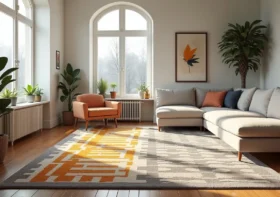Eco-Friendly Upgrades to Consider for a New Home

Many new homeowners are considering ways to incorporate eco-friendly upgrades in their homes. As you set out to create a space that respects nature and reduces wasted energy, you might be wondering where to begin. While every newly built house has its own unique quirks, there are tried-and-tested strategies to cut carbon emissions while enhancing comfort. Below, you’ll find ideas to help shape a home that’s kinder to the planet and easier on your wallet, all without sacrificing personal style.
Contents
- 1 Go for Energy-Efficient Windows and Proper Insulation
- 2 Harness Solar Energy for Long-Term Savings
- 3 Install Water-Saving Fixtures and Smart Plumbing
- 4 Choose Low-VOC Paints and Finishes
- 5 Incorporate Sustainable Building Materials
- 6 Upgrade to Energy-Saving Appliances
- 7 Explore Smart Thermostat Options
- 8 Think About Natural Landscaping Approaches
- 9 Make the Most of Natural Light and Ventilation
- 10 Invest Wisely and Stay Open to Innovation
Go for Energy-Efficient Windows and Proper Insulation
A significant chunk of a home’s energy loss comes from gaps in windows and under-insulated walls. By opting for double or triple-pane windows, you reduce heat transfer, keeping the interior cozy in winter and pleasantly cool in summer. Insisting on quality insulation in walls, roofs, and floors helps ensure energy-efficient performance, especially when outside temperatures drop. This not only boosts home efficiency overall but also contributes to lower electricity bills every month.
Air Sealing for Better Comfort
Insulation works best when paired with airtight sealing, especially around window frames and doors. A little attention to these areas makes heating and cooling systems work more effectively. Drafts near doors and window sills might not seem alarming, yet they can lead to constant temperature fluctuations indoors. Addressing tiny openings in your home’s shell can guarantee a consistently comfortable living environment.
Harness Solar Energy for Long-Term Savings
Solar panels have become a symbol of modern green architecture, and they’re a smart step if you want reliable, renewable energy. While the initial price tag might feel substantial, government incentives often help offset this cost. Over time, solar power can shrink your electricity bills and lessen dependence on fossil fuels. Even smaller setups, like solar water heaters, can make a notable difference by lowering traditional energy usage.
Considering Roof Placement
Before jumping into solar adoption, take a look at how much sunlight your roof gets each day. Homes with south-facing roofs generally capture more direct sun. If your property has tall trees or neighboring structures that cast shade, specialized solutions like ground-mounted panels might be worth exploring. Consulting with a solar professional can clarify the best setup for your property’s location and design.
Install Water-Saving Fixtures and Smart Plumbing
Saving water is a vital aspect of environmentally friendly living, and simple fixtures can create a big impact without disrupting your daily routine. Low-flow toilets and faucets, for example, minimize water usage every time someone flushes or runs the tap. Installing efficient showerheads cuts down on gallons of water wasted during long showers, translating to real financial savings over time.
By pairing these upgrades with smart plumbing systems, leaks are reduced and less water is wasted before repairs. Alerts from intelligent leak detectors ensure early action, preventing hidden drips that inflate your utility bills. Over time, you’ll see how small changes to your water habits can make a lasting difference in preserving precious resources.
Choose Low-VOC Paints and Finishes
Many homeowners focus on visible features when building a place, but often ignore the invisible chemicals lurking in paints and finishes. Traditional options can release volatile organic compounds (VOCs) into the air, affecting indoor air quality. Low-VOC or zero-VOC paints dramatically cut back on harmful emissions, making your space safer to breathe in. This is especially valuable if you or family members are sensitive to strong odors or prone to allergies.
Embracing Non-Toxic Flooring
Flooring choices can further boost a home’s eco-quotient. Bamboo and cork, for instance, are renewable materials that offer natural resilience. Engineered hardwood certified by reputable organizations also ensures fewer chemicals in your home, plus better sustainability. Choosing finishes that minimize off-gassing adds another layer of freshness to newly installed floors.
Incorporate Sustainable Building Materials
In a world focused on greener solutions, integrating sustainable materials into your construction plan adds unmatched value. Reclaimed wood, recycled metal, and eco-friendly concrete blends can form the foundation of a healthier, sturdier space. Some of these materials have interesting textures and stories, giving your interiors a distinctive style. Opting for them also aids waste reduction by extending the lifecycle of resources.
An added bonus is that many green building materials feature excellent durability. Products like fiber cement siding or composite decking don’t need frequent replacement, which drives down maintenance costs. Plus, sustainable materials often align with certifications that boost a home’s appeal if you ever consider selling.
Upgrade to Energy-Saving Appliances
High-efficiency appliances go far beyond the usual suspects of washers and dryers. Modern refrigerators, dishwashers, and ovens are all built with innovative technology that uses less electricity or water. Look for trusted labels that confirm lower consumption levels without sacrificing performance. Over the course of a year, this can drastically reduce both utility bills and the household’s environmental footprint.
Replacing older HVAC systems with more efficient units is also crucial. Outdated heating and cooling devices tend to burn through electricity, especially in climates demanding significant temperature control. By transitioning to advanced furnaces, air conditioners, or heat pumps, you ensure your family’s comfort while preserving natural resources.
Explore Smart Thermostat Options
A smart thermostat helps manage indoor climates around the clock and learns household routines over time. These devices automatically adjust settings, so you don’t waste energy cooling an empty house or heating rooms nobody uses. Many come with mobile applications that let you tweak temperatures from anywhere. This technology leverages real-time data to maximize comfort and keep monthly bills in check.
For extra efficiency, connect your thermostat to sensors in different parts of the home. That way, you end up with precise adjustments based on each room’s usage. These systems help distribute warmth or cool air exactly where it’s needed, limiting waste and ensuring everyone stays comfortable.
Think About Natural Landscaping Approaches
Landscaping can be more than just decorative it can be a key part of your eco intentions. Selecting native plants that thrive in local conditions reduces water and maintenance needs. Mulching around shrubs and flower beds holds onto moisture, further limiting how often you need to turn on the sprinklers. Strategic planting of trees can offer natural shade during the hottest part of the day, easing pressure on your cooling system.
Rain gardens and permeable paving are also on the rise for those concerned about water runoff. They allow water to soak into the soil instead of carrying contaminants to storm drains. By embracing nature-friendly landscaping, you nurture biodiversity and help create a healthier local ecosystem.
Make the Most of Natural Light and Ventilation
New homes often have the advantage of being designed with ample window space, so be sure to use it to your benefit. Natural light cuts down on daytime lighting needs while giving rooms a welcoming atmosphere. Thoughtful placement of windows or skylights can also help with cross-ventilation, pushing stale air out and inviting fresh air in. In many regions, simply cracking a window at certain times of the day leads to a cool, refreshing breeze.
Ceiling fans are another investment that pairs perfectly with open windows. They keep air circulating, making rooms feel more comfortable without forcing your cooling system into overdrive. Subtle changes like these can have a major impact on keeping your space both bright and breezy.
Invest Wisely and Stay Open to Innovation
These days, technology evolves quickly, and new possibilities for living sustainably pop up all the time. If an option seems too cutting-edge, take the time to research it; some of the most efficient systems started off as niche products. Keep track of emerging trends and incentives that can save you money while pushing your home toward even better environmental performance.
Eco-friendly upgrades require balanced choices, good research, and a willingness to adapt. As you settle into your new place, every small decision from the type of appliances you install to the materials under your floors can shape the environmental legacy of your home. Thoughtful planning ensures that your living space remains in harmony with the planet, now and in the years ahead.



